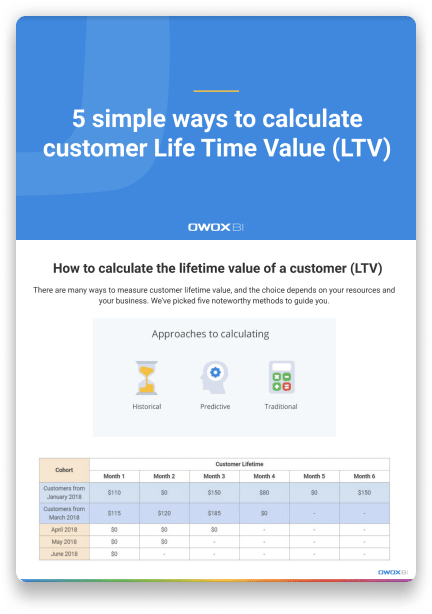Table of contents
- What is Customer Lifetime Value (CLV)?
- Importance of Customer Lifetime Value (CLV) in Marketing
- How to Measure Customer Lifetime Value (CLV)
- How to Calculate Customer Lifetime Value (CLV)
- Understanding Customer Acquisition Cost vs Customer Lifetime Value
- Examples of How to Measure Customer Lifetime Value
- Tips to Improve Customer Lifetime Value (CLV)
- Maximizing Customer Lifetime Value with OWOX BI
What is Customer Lifetime Value (CLV)
Ievgen Krasovytskyi, Head of Marketing @ OWOX
Olha Diachuk, Creative Writer @ OWOX
Want to know how to gain clients, boost profits, and save your budget? Among all the main digital marketing metrics, there’s a special one that can tell you what value a buyer brings to your company during the customer life cycle.
Let’s discover the customer lifetime value (CLV or LTV) meaning and make the most of this metric for your business.

If you need an all-in-one marketing performance report or you need to visualize any other metrics and dimensions valuable for your business, start your OWOX BI free trial right now.
Note: This post was originally published in January 2021 and was completely updated in February 2024 for accuracy and comprehensiveness.
What is Customer Lifetime Value (CLV)?
Customer lifetime value (CLV, CLTV, or LTV for “lifetime value”) definition is that it helps you predict future revenue and measure long-term business success. CLV tells you how much profit your company can expect from a typical client for the relationship. More to the point, CLTV's meaning is to help you estimate how much you should invest in order to retain a regular shopper.
Actually, that amount depends on your margins. One company may spend up to $1 to retain a buyer while another spends up to $50. To figure out how much you should invest, you need to know how to estimate the lifetime value of a customer for your business.
According to Forbes, there’s a 5–20% probability that you’ll sell your product or service to a new consumer, whereas the chance of selling it to an existing client is about 60–70%. Retention is a lot cheaper than acquisition.
Thus, successful marketers don’t focus only on strategies for acquiring new clients. They also work out tactics to retain shoppers and stimulate them to make more purchases. CLTV gives an understanding of your promotion spending, based on which you can further optimize and plan your budget. CLV also provides useful insights into how to encourage buyers to spend more.
Knowing the lifetime value of a consumer allows you to answer these questions:
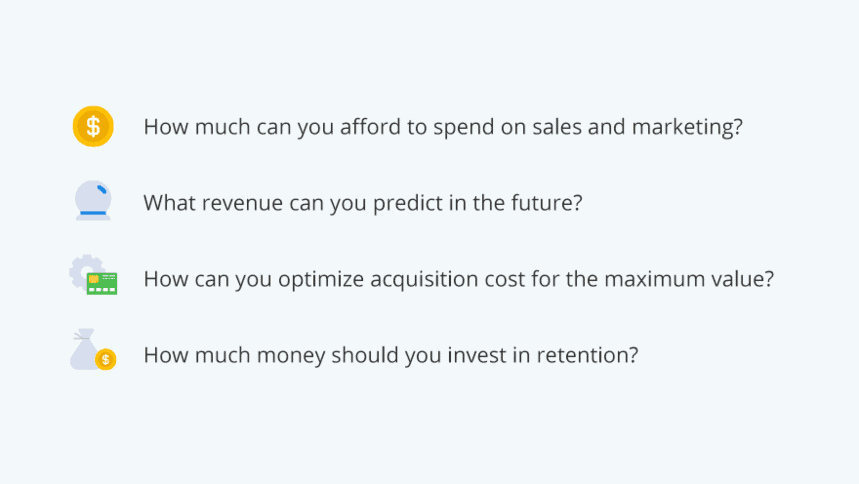
Importance of Customer Lifetime Value (CLV) in Marketing
The importance of Customer Lifetime Value (CLV) in marketing is significant, as it provides a comprehensive understanding of the long-term value of customers to a business. Here are key reasons why CLV is essential in marketing:
- Guiding Marketing Spend: CLV helps in allocating marketing budgets more effectively. By understanding which customers are most valuable over time, businesses can tailor their spending to acquire and retain high-value customers, ensuring a better return on investment.
- Enhancing Customer Segmentation and Targeting: Knowing the CLV allows marketers to segment their audience more accurately and target customers with the highest potential value. This leads to more personalized and effective marketing campaigns.
- Improving Customer Retention Strategies: CLV emphasizes the importance of retaining customers. Increasing customer retention rates by 5% increases profits by 25% to 95%. It often costs less to retain an existing customer than to acquire a new one. Understanding the lifetime value of customers can lead to more focused and effective retention strategies.
- Driving Business Growth and Profitability: High CLV is indicative of customers who contribute significantly to the revenue over time. Focusing on increasing CLV can drive sustainable business growth and profitability.
- Informing Product Development and Innovation: CLV data can provide insights into the needs and preferences of the most valuable customers, guiding product development and innovation towards offerings that meet these customers' needs.
- Creating Long-Term Relationships: By focusing on CLV, businesses are encouraged to create and maintain long-term relationships with their customers, fostering loyalty and trust.
- Optimizing Customer Experience: Understanding the value of customers over their lifetime motivates businesses to optimize customer experiences, as positive experiences can significantly impact CLV.
CLV is a very important metric in marketing, not just for measuring customer value, but also for informing strategic decisions across various aspects of marketing performance and business operations, ultimately leading to more customer-centric and profitable practices.
How to Measure Customer Lifetime Value (CLV)
There are many ways to measure customer lifetime value, and the choice depends on your resources and your business. Of course, the harder it is to get information to include, the harder it is to calculate CLV. A complex product, segregated teams, and untargeted marketing are the main reasons why it’s difficult for large companies to estimate CLTV.
There are 3 approaches or models for calculating CLV — historical, cohort, and predictive.
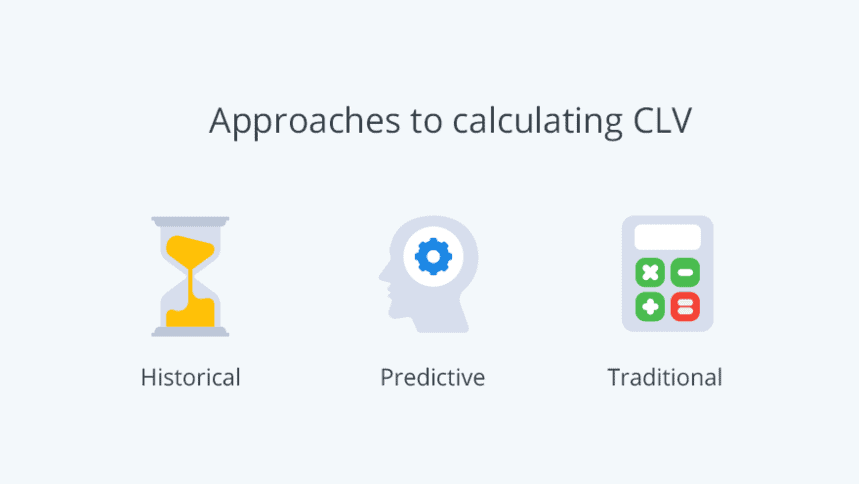
The historical approach is based on the gross profit sum from purchases your shoppers have made in the past. It’s not difficult to do this calculation, since you only need data on previous purchases.
The historical approach is valid only if your clients have similar preferences and stay with your company for the same period of time. They don’t consider changes in customer behavior.
So if your buyers change their interests and the way they purchase, it will affect the outcome.
Cohort analysis takes the average revenue per user (ARPU) approach further. A cohort is a group of clients who have similar characteristics and made their first purchase during the same month in their customer journeys.
Using cohort analysis, you calculate the average revenue per cohort instead of per user. In addition to calculating customer lifetime value, cohort analysis can help you find the number of loyal clients, improve lifetime value by finding the points where purchasing drops off, and accurately assess ad campaign performance.
The historical and cohort methods are simple, however, they can’t be used for predictions.
Using predictive modeling for calculating CLTV aims to model a customer’s transactional behavior and predict what they’re likely to do in the future. It’s more precise than historical CLV because it applies algorithms that can predict the total value of a buyer. Along with past purchases, this approach accounts for a client’s actions.
Although this approach is better than the historical model, you still need to consider that the predictions may be misleading. We’re just guessing the customer lifespan based on monthly data.
For more accurate results, you should adjust the CLTV formula to your industry and business strategies.
How to Calculate Customer Lifetime Value (CLV)
The Customer Lifetime Value (CLV) standard formula is:
This formula helps in estimating the revenue expected from an average customer over the course of their relationship with your business.
While Customer Lifetime Value (CLV) generally assesses the collective value of all customers, CLV can be applied to evaluate the business value of specific customers or customer segments.
Although this is the basic formula for calculating CLV, the process of determining this critical metric can sometimes be complex and multifaceted.
Now let's look at the steps on how to calculate CLV:
Step 1: Calculating Average Order Value (AOV)
To find the average order value, tally up the total revenue accrued from all customer orders over a chosen time period. Then, divide this sum by the total count of orders placed. This calculation reveals the average spending per order by customers, providing insights into the revenue per transaction for your business.
Step 2: Calculating Transaction Frequency (F)
To determine the frequency of transactions, monitor the purchasing patterns of individual customers over a set period. To quantify this, divide the total number of transactions during that period by the number of customers. This will give you an average of how frequently each customer makes a purchase from your business.
Step 3: Assessing Customer Retention Duration
Evaluate the average period that customers remain engaged with your business. This involves analyzing the period from a customer’s initial purchase to their most recent transaction. Compute this average duration by considering all customers to understand how long they typically stay loyal to your business.
Step 4: The Final Formula
To calculate the Customer Lifetime Value (CLV) for a single customer, you can use two methods:
- Multiply the Average Order Value by the Total Number of Transactions.
- Alternatively, multiply the Average Order Value by the Number of Transactions each month, and then multiply that by the Average Length of the Customer Relationship in months.
This calculation helps you understand the total revenue you can expect from a customer throughout their relationship with your business. With this insight, you can strategize ways to enhance the customer's value, such as through loyalty programs, upselling techniques, or special combo offers, aiming to boost your business's overall revenue.
Understanding Customer Acquisition Cost vs Customer Lifetime Value
Customer Acquisition Cost (CAC) is basically what you spend to get new customers. You figure it out by adding up all your marketing and sales costs and then dividing that by the number of new customers you have. It's a handy way to see if your strategies for getting customers are good value for money. Then there's Customer Lifetime Value (CLV), which is all about the long haul. It's the total cash you expect to make from a customer over the whole time you're doing business with them.
While CAC is all about the early days of hooking customers, CLV is your big picture – it's about keeping those customers around and how valuable they are over time. Getting the balance right between these two is super important for a business that wants to keep growing. When your CLV is way higher than your CAC, that's a great sign – it means you're not just getting customers, you're keeping them and they're bringing in good money.
Let's look at a table for the differences for a more clear understanding:
Aspect | Customer Acquisition Cost (CAC) | Customer Lifetime Value (CLV) |
Definition | The cost associated with acquiring a new customer. | The total revenue a business expects from a customer throughout their lifecycle. |
Focus | Measures the effectiveness and efficiency of acquisition strategies. | Represents the long-term value of customer relationships. |
Calculation | Total acquisition costs are divided by the number of customers acquired during a specific period. | Predicted revenue from a customer, discounted to present value, over their relationship with the company. |
Timeframe | Short-term focus, often calculated over specific campaigns or time periods. | Long-term focus, considering the entire duration of a customer's relationship with the business. |
Purpose | To evaluate the cost-effectiveness of marketing and sales efforts. | To understand the profitability and value derived from customer relationships. |
Strategic Impact | Helps in optimizing marketing spend and strategy for customer acquisition. | Guides decisions related to customer retention, loyalty programs, and upselling/cross-selling strategies. |
Desired Scenario | Lower CAC is preferable, indicating efficient use of resources in acquiring customers. | Higher CLV is preferable, indicating greater revenue potential from customer relationships. |
Calculating the CLV to CAC Ratio
Understanding the CLV to CAC Ratio is a vital component in assessing a company's financial health and customer relationship efficiency. This metric offers insights into the return on investment for customer acquisition efforts.
The CLV:CAC ratio is determined by dividing a customer's lifetime value (LTV) by the customer acquisition cost (CAC).
For instance, if your business's CLV is $1,000 and the CAC is $170, the ratio is calculated as follows:
$1,000:$170=5.88
This results in a ratio of $5.88:$1, implying that for each dollar invested in acquiring customers, the business is expected to earn nearly six dollars in lifetime revenue from these customers.
Guide: Top 9 Tips to Reduct CAC
Uncover in-depth insights
Top 9 Tips to Reduce Customer Acquisition Cost
Download nowBonus for readers
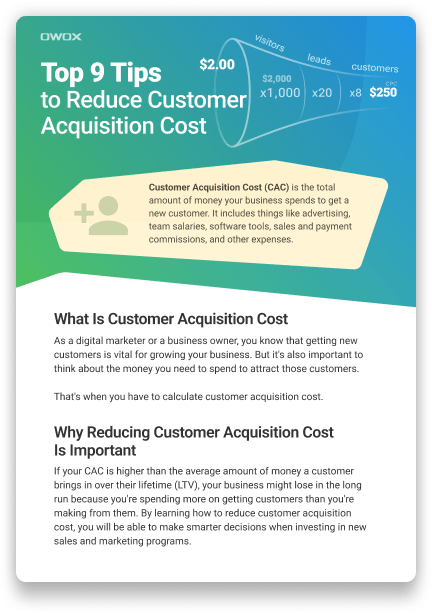
Examples of How to Measure Customer Lifetime Value
Measuring Customer Lifetime Value (CLV) is essential for businesses to understand the long-term value of their customer relationships and to make informed decisions on marketing, sales, and customer service strategies. We will explore four methods with examples to calculate Customer Lifetime Value (CLV), each offering unique insights based on different aspects of customer behavior and business data.
Method #1: Simple Historical CLV
This method estimates the Customer Lifetime Value (CLV) using historical profit data from a specific group of customers. It calculates the average revenue generated by these customers over a shorter period and then projects this average over a longer term, typically a year.
Let's look at an example using ARPU as a unit using historical CLV:
Calculate ARPU for a Short Period
ARPU represents the average revenue generated per customer over a specified period. It's a way to measure how much revenue each customer contributes on average.
Calculation in Example: With 20 shoppers bringing in a total profit of $1,240 over three months, you first calculate the ARPU for this period. Divide the total profit ($1,240) by the total number of customers (20).
ARPU Calculation: $1240 / 20 = $62.
Result: This gives an ARPU of $62 for the three months, indicating that, on average, each customer contributes $62 in profit over these three months.
Annualize the ARPU
Annualizing ARPU means extending this average revenue per user to a full year. This is done by multiplying the short-term ARPU by the number of similar periods in a year.
Calculation in Example: Since a year comprises four 3-month periods, multiply the 3-month ARPU by 4.
Annualized ARPU Calculation: $62 (ARPU for 3 months) × 4 = $248.
Result: This suggests each customer is expected to contribute $248 in profit over the course of a year.
So here, the annualized ARPU is now considered the Customer Lifetime Value (CLV) for the period of one year. It's an estimation of the total value each customer brings to the business annually, based on historical data. The historical CLV in this scenario is $248 per customer per year.
Method #2: Cohort Analysis - CLV
Cohort Analysis CLV focuses on groups (cohorts) of customers based on their start time with the business. It analyzes how much revenue each cohort brings over time. This method is useful to see how customer behavior and spending change over different periods.
Taking the above example, we’ll calculate the ARPU per month for the cohort named Customers from January 2023 that joined in January 2023 and the cohort Customers from March 2023 that joined in March 2023.
Calculate Monthly ARPU for Each Cohort
ARPU is the average revenue each customer from a specific cohort contributes in a month.
Calculation: Suppose each cohort has 20 customers, and they bring different profits each month. You calculate ARPU for each month by dividing the total profit by the number of customers in that cohort.
Analyze Monthly Trends
Examine the monthly ARPU for each cohort. This will show you how spending behavior changes over time for each group.
Example Insight: If the January cohort's spending decreases over time, the same trend might be expected for the March cohort.
Estimate CLV for Each Cohort:
By understanding these monthly trends, you can estimate how much revenue a customer from each cohort will bring over a longer period, like a year.
Annualized CLV: Combine the monthly ARPUs to project the annual revenue from each customer in the cohort.
Note: This table shows that purchases differ from month to month. Suppose your cohorts are not that different. In this case, the March cohort will likely also go silent for some period of time.
So, in the above example, we took Cohort Analysis CLV, and we calculated the monthly ARPU for two groups: customers who started in January 2024 and those who started in March 2024.
By tracking and comparing their monthly spending, we identify trends. For instance, if the January cohort shows a decline in ARPU after six months, and the March cohort exhibits a similar trend, this information can be used to predict future revenue and estimate the Customer Lifetime Value (CLV) for these cohorts. This approach helps in understanding customer behavior over time and in making informed decisions.
Method #3: Advanced Predictive CLV
This method provides a nuanced and accurate calculation of Customer Lifetime Value (CLV) by taking into account several metrics that reflect the customers' interactions with the business over time. It not only looks at past profits but also factors in the behavior patterns and lifespan of the customer relationship. Lets look at an example of calculating the metrics used:
Average Number of Transactions (T)
The Average Number of Transactions (T) is a measure of how often a customer purchases within a specific timeframe. It’s found by dividing the total transactions by the number of customers in that period.
Example Calculation: Over 6 months, 120 transactions were made. To find T, divide the total transactions by the number of months: 120 transactions / 6 months = 20 transactions per month.
Average Order Value (AOV)
Average Order Value (AOV) is a metric that represents the mean revenue earned from each transaction made by customers. It's calculated by dividing total revenue by the number of orders.
Example Calculation: With total revenue of $12,000 from 20 orders in November, AOV is $12,000 / 20 = $600.
Average Gross Margin (AGM)
AGM is the average gross margin, which tells you what part of each sale is your actual profit and what part is the cost (expressed as a percentage).
Example Calculation: Total revenue (November): $12,000
Cost of sales: $8,000
Gross margin (%) = (($12,000 — $8,000) / $12,000) × 100 = 33%
Let’s take six months to get the average:
Total gross margin: 1.64
AGV = 1.64 / 6 = 0.27, or 27%
Average Customer Lifespan (ALT):
Average Customer Lifespan (ALT) gauges the typical duration a customer remains active and makes purchases from a business. It’s the expected time period a customer will continue to contribute to a company's revenue.
Churn Rate Calculation: With 200 clients at the start and 150 at the end of November, the churn rate is (200 - 150) / 200 = 25%. So, ALT is 1 / 0.25 = 4 months.
Final Calculation of Predictive CLV:
Finally, we have all the metrics for our CLTV prediction formula:
Average number of transactions per month (T) = 20
Average order value (AOV) = $600
Average gross margin (AGM) = 27%
Average customer lifespan in months (ALT) = 4 months
CLV (total) = 20 × $600 × 27% × 4 = $12,960
Now, we should take into account the total number of existing buyers at the end of the latest month, November, which was 150.
Predicted CLV = $12,960 / 150 = $86,40
Using this advanced method, we calculate a predictive CLV that offers a forward-looking estimate of the value each customer brings to the business. It is grounded in historical data but adjusted for customer behavior patterns, allowing for a more dynamic and accurate assessment of customer value. The calculated CLV in this scenario is $86.40 per customer, which provides a sophisticated metric for future revenue projections and strategic decision-making.
Method #4: Traditional CLV Calculation
This approach computes the Customer Lifetime Value (CLV) by considering not just historical profits but also the retention rates and the time value of money through a discount rate. It's ideal for businesses with non-uniform sales patterns over time.
If you don’t have flat yearly sales, you can rely on a traditional CLV formula. It’s possible to consider the discount rate, average gross margin per lifespan of a single customer, and retention rate.
The formula is:
Gross Margin Lifetime (GML)
Gross Margin Lifetime (GML) is a measure of the total profit a company expects to make from a customer throughout the entire business relationship.
It's calculated by multiplying the customer's average total revenue by the company's gross margin percentage.
GML = Gross Margin (%) × Average Total Revenue per Customer
Calculation in Example:
Gross margin( GM)- This represents the percentage of total revenue that is profit after subtracting the cost of goods sold (COGS).
In the example given, the gross margin is 27%, meaning that 27% of each sale is profit.
Average total revenue (ATR)- This is the average revenue that a customer generates. In the example, the average total revenue per customer is $900.
GML- To find the GML, you multiply the gross margin percentage by the average total revenue per customer.
0.27 × $900 = $243
This gives you the average expected profit from a customer over the time they do business with you.
Retention Rate (R)
The retention rate, R, is the percentage of clients who made a repeat purchase over a particular period, compared to the previous period.
Calculation in Example: Let’s suppose that in November you had:
CE (Customers at the End of the period): This is the number of customers you have at the end of the period, which in this case is November.
Here, CE = 250.
CN (New Customers acquired during the period): These are the customers that are new or first-time buyers during the period. In November, you acquired
CN = 50 new customers.
CB (Customers at the Beginning of the period): This is the number of customers you had at the start of the period, before gaining any new customers.
For November, CB = 220.
R = ((250 — 50) / 220) × 100 = (200 / 220) × 100 = 0.9 × 100 = 90%
Discount Rate (D)
The percentage of customers who continue to purchase over time.
D is the discount rate.
Calculation in Example: We’ll take a standard 10% discount rate.
A standard rate (e.g., 10%) that adjusts future revenue to present value, accounting for inflation.
Traditional CLV Calculation
Now we have all the figures needed to calculate traditional CLV:
Using the GML, retention rate, and discount rate, the CLV is calculated as
CLV Calculation = $243 × (0.9 / (1 + 0.1 — 0.9)) = $243 × (0.9 / 0.2) = $243 × 4.5 = $1,093.50
This formula covers all possible changes in revenue during a particular period. In order to take into account inflation, each subsequent year should be adjusted by a discount rate. The traditional CLV provides a dynamic valuation of a customer, factoring in the retention rate and the time value of money. It gives a more comprehensive view compared to the Simple Historical CLV method.
In this scenario, the Traditional CLV per customer is estimated at $1,093.50, which provides a valuable metric for financial forecasting and strategic planning.
Measure CPO and ROAS in GA4
Automatically link your Ad Platforms cost data to Google Analytics 4 conversion data, so you can analyze your marketing KPIs and make fully informed decisions
4.9
Tips to Improve Customer Lifetime Value (CLV)
Is my CLV normal? There’s nothing like “normal” for CLTV. Any CLV is normal if your business stays alive. You should concentrate on how to increase your Customer Lifetime Value at any stage of your business development. And if you want a sign from above, here are some interesting statistics: if your CLV is three times your CAC, everything is going well. If not, you have a lot of things to do to improve the situation.
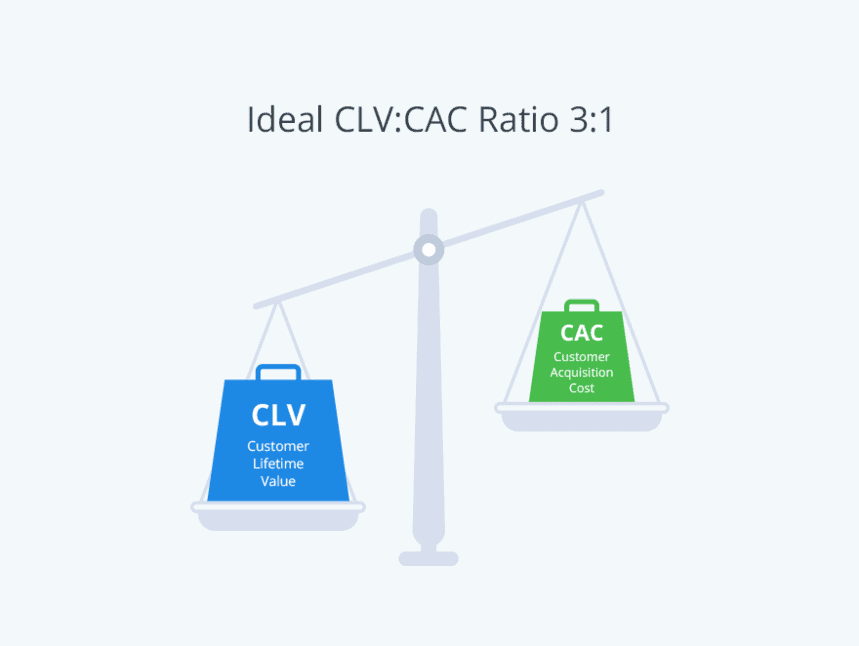
To boost your CLV figures, you should continuously work to improve your customer-brand connection. Here are a few options for how to achieve a lasting and positive customer relationship:
- Launch a loyalty program: You can use different forms: client cards or mobile applications, earning points only by customer phone number, and much more. The main thing remains unchanged. You offer customers personal discounts and other benefits.
- Improve your customer experience: All touchpoints with customers (online and offline stores, support centers, social networks, etc.) should be monitored continuously. Listen to your customers and make the necessary changes if needed.
- Enhance Onboarding Processes: In sectors like SaaS or fintech, a smooth onboarding experience is crucial for customer retention. Simplifying sign-up and tailoring experiences increases customer satisfaction and loyalty, directly impacting LTV.
- Reward Top Customers: Recognizing and offering exclusive benefits to your most valuable customers fosters a sense of appreciation, encouraging long-term loyalty and enhancing LTV.
- Implement Omnichannel Support: Providing consistent and seamless support across various platforms, like websites, apps, and social media, builds trust and customer loyalty
- Leverage Social Media: Engage customers with compelling content, timely responses, exclusive promotions, and influencer collaborations on social media to boost loyalty and LTV.
- Adopt Closed-Loop Feedback: Promptly address customer feedback and make necessary improvements. Showing customers that their opinions are valued strengthens loyalty and increases LTV.
Maximizing Customer Lifetime Value with OWOX BI
Customer lifetime value helps you find the balance. You can figure out how much to invest to retain your existing customers and acquire new ones. You’ll get an idea from CLV investigations of how to build customer loyalty and increase sales. If you keep your clients satisfied, they’ll stay longer and continue to purchase from you.
Simply by calculating CLTV, you can improve your business in all directions.

Gain clarity for better decisions without chaos
No switching between platforms. Get the reports you need to focus on campaign optimization
OWOX BI simplifies Customer Lifetime Value (CLV) optimization by integrating data from various channels, offering insights through consolidated, automatically updated visualizations. This includes tracking orders, revenue per user, and comparing AOV, CAC, and LTV. Automated reports help evaluate ad effectiveness, while behavioral tracking identifies cross-selling opportunities, enhancing customer engagement and boosting long-term revenue.
FAQ
-
Can CLV Vary by Industry?
Yes, CLV can vary greatly by industry due to differences in customer behavior, product lifespan, and buying cycles. Industries with high-value products or services, such as luxury goods or real estate, often have a higher CLV compared to industries with lower value or more frequent purchases, like fast-moving consumer goods. -
How Does CLV Influence Marketing Strategies?
CLV significantly impacts marketing strategies by guiding decisions on customer acquisition and retention. Understanding the value of a customer over their entire relationship with the company allows marketers to allocate budgets more effectively. -
What does CLV mean?
Customer lifetime value (CLV, or LTV for «lifetime value») helps you predict future revenue and measure long-term business success. CLV tells you how much profit your company can expect from a typical client over the course of the relationship. -
How do you calculate CLV?
There are many ways to measure customer lifetime value, and the choice depends on your resources and your business. There are 3 approaches to calculating CLV (historical, cohort, and predictive) and 4 methods to calculate the metric. -
What is the CLV for an average customer?
The average customer CLV is an average customer lifespan multiplied by customer value. -
What are the benefits of CLV?
By calculating CLV, you can improve your business in all directions. You can figure out how much to invest in order to retain your existing customers and to acquire new ones. If you keep your customers satisfied, they’ll stay longer and continue to purchase from you.
